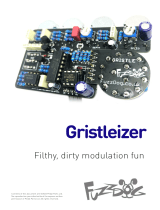Page is loading ...

Blender V2
Sometimes one signal
is just not enough
Contents of this document are ©2022 Pedal Parts Ltd.
No reproduction permitted without the express written
permission of Pedal Parts Ltd. All rights reserved.

Important notes
If you’re using any of our footswitch daughterboards,
DOWNLOAD THE DAUGHTERBOARD DOCUMENT
•Download and read the appropriate build document for the daughterboard
as well as this one BEFORE you start.
•DO NOT solder the supplied Current Limiting Resistor (CLR) to the main
circuit board even if there is a place for it. This should be soldered to the
footswitch daughterboard.
POWER SUPPLY
Unless otherwise stated in this document this circuit is designed to be
powered with 9V DC.
COMPONENT SPECS
Unless otherwise stated in this document:
•Resistors should be 0.25W. You can use those with higher ratings but
check the physical size of them.
•Electrolytics caps should be at least 25V for 9V circuits, 35V for 18V
circuits. Again, check physical size if using higher ratings.
LAYOUT CONVENTIONS
Unless otherwise stated in this document, the following are used:
•Electrolytic capacitors:
Long leg (anode) to square pad.
•Diodes/LEDs:
Striped leg (cathode) to square pad. Short leg to square pad for LEDs.
•ICs:
Square pad indicates pin 1.

Schematic + BOM
R1 1M
R2 1M
R3 3K3
R4 100K
R5 100K
C1 1u
C2 10u elec
Q1 2N5457 - Other FETs should work fine, but this is what we use.
BLEND 100KA
LEVEL 100K trim

PCB layout ©2021 Pedal Parts Ltd.
The power and signal pads on the PCB conform
to the FuzzDog Direct Connection format, so can
be paired with the appropriate daughterboard for
quick and easy offboard wiring. Check the
separate daughterboard document for details.
Be very careful when soldering the FET. They’re
very sensitive to heat. Use some kind of heat
sink (crocodile clip or reverse action tweezers)
on each leg as you solder them. Keep exposure
to heat to a minimum (under 2 seconds).
Snap the small metal tag off the pot so it can be
mounted flush in the box.
The timmer sets the level of the signal coming
back into the Blender from the main circuit (i.e.
Receive). There are extra pads to enable the use
of different trimmer types. The pads are linked
by traces on the PCB as shown above,
so you only need one leg inserted per line.
MORE INVOLVED STUFF
There are two sets of I V G O pads
We’ve designed this board to make it very easy to
use with the rest of our PCBs utilising the Direct
Connect format for the power and signal
connections. Of course you don’t have to use
these with ribbon cables, or even use the
Blender with our PCBs, but the option is there.
The set of pads marked in red here are your
main connections. Your main input should go to
this IN pad, and your main output should go to
this OUT pad. You also need to get power to
these V and G pads. The next page shows how
the boards will connect if using one of our
footswitch daughterboards.
The set of pads in blue is your Send and Receive
connections for the circuit you want to blend in.
IN is Send, i.e. it connects to the IN of the second
circuit. OUT is Receive, and connects to the OUT
of the second circuit. You can use the V and G
pads to power the second circuit if you want to.
Both sets of V and G pads are directly connected
on the PCB.

CONNECTING THINGS UP
The Blender circuit just slots in between your
main circuit and whatever that would have been
connected to normally.
You don’t have to use the second set of V and G
pads on the Blender to power your main circuit,
it’s entirely optional. You should however ensure
there is a shared ground connection between
the two.
Example - in a normal pedal setup:
Input Jack > footswitch
Footswitch > Circuit In
Circuit Out > Footswitch
Footswitch > Output jack
Becomes:
Input Jack > footswitch
Footswitch > Blender In
Blender SND (IN2) > Circuit In
Circuit Out > Blender RCV (OU2)
Blender Out > Footswitch
Footswitch > Output jack
Your normal in/out and power connections

BLENDER PEDAL SETUP
You can use the blender to make a self contained
blend pedal. Why not?
SEND RECEIVE
OUT
IN
/









